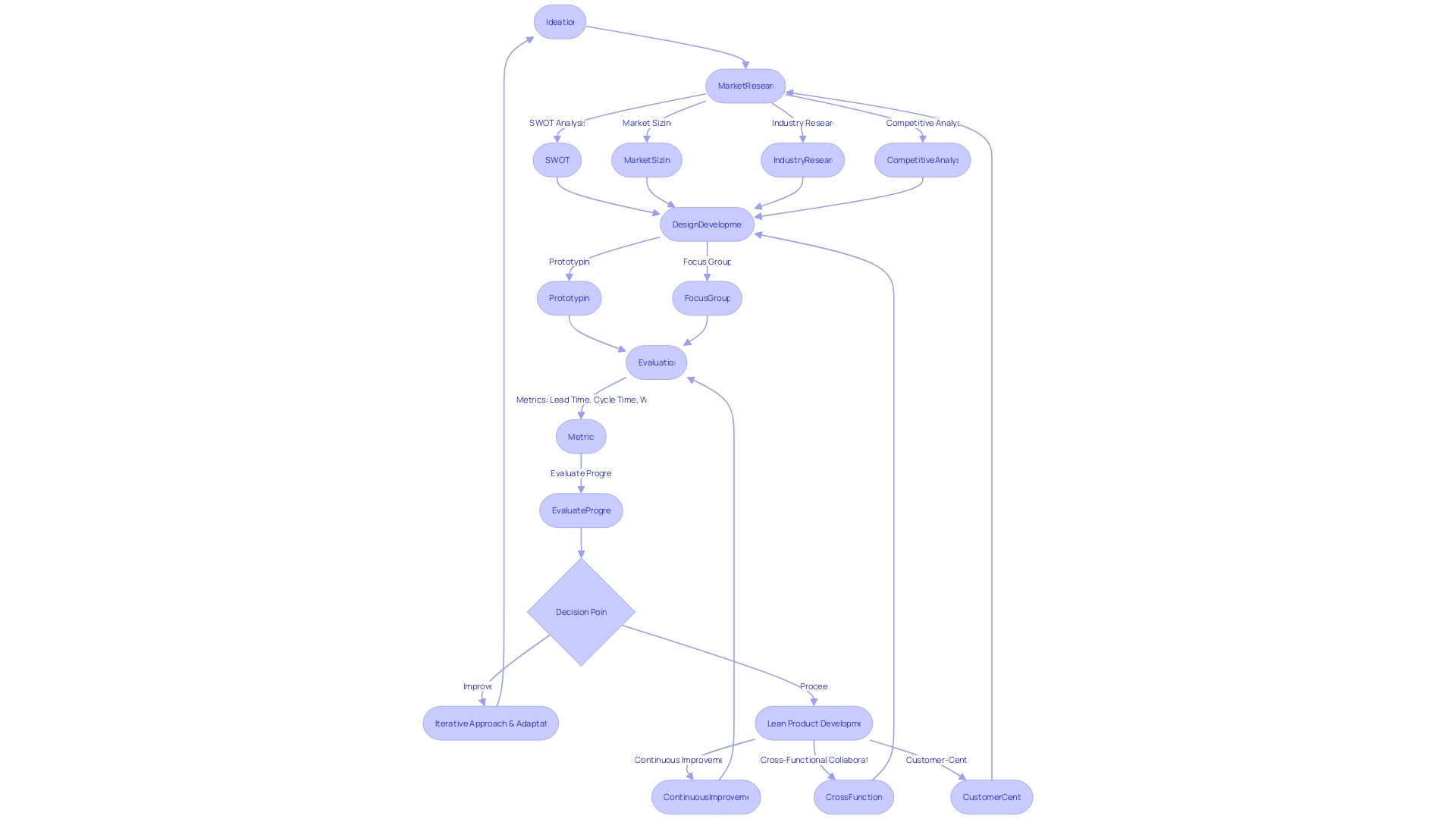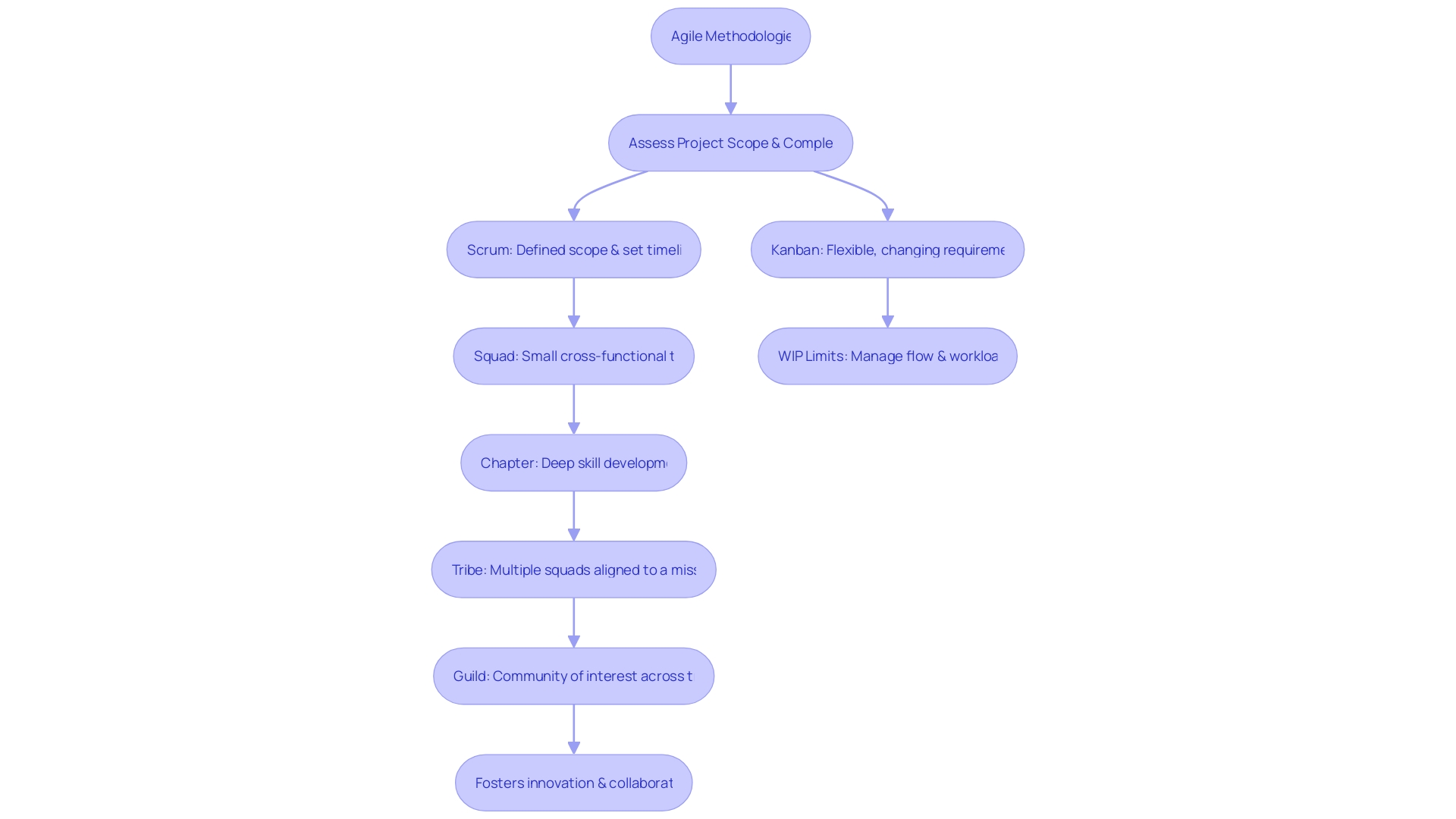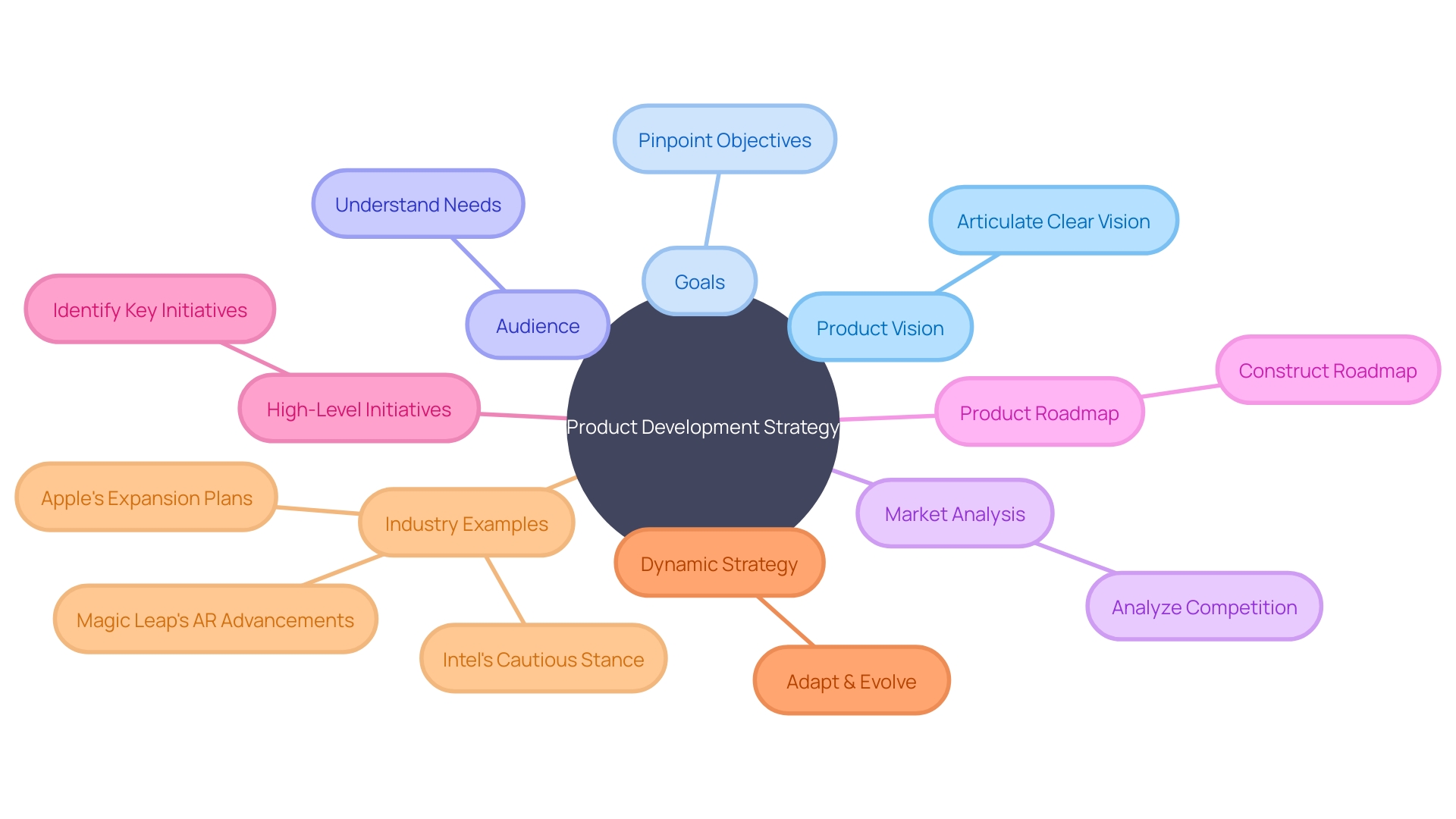Introduction
Assembling a top-tier product development team requires a clear understanding of the roles within the team. This article explores the distinction between product teams and feature teams and the implications of misalignment.
It also emphasizes the importance of effective communication and collaboration in cross-functional teams, highlighting the benefits of diversity and open dialogue. Additionally, the article delves into the establishment of a streamlined product development process, focusing on the agile methodology and continuous improvement.
It further discusses the key principles and attributes of product squads and the organization of agile teams into squads, chapters, tribes, and guilds. Lastly, the article addresses the creation of a robust product development strategy, emphasizing the importance of a clear vision, market analysis, and goal-setting. By following these insights, businesses can enhance the effectiveness and success of their product development teams.
Understanding the Role of Product Teams vs. Feature Teams
Assembling a top-tier product development team necessitates a keen understanding of the roles within the team. A common pitfall is the conflation of product teams with feature teams.
Product teams are the visionaries, tasked with crafting the strategic direction and roadmap of a product. They are outcome-oriented, laser-focused on achieving business results.
Feature teams, on the other hand, are the executors, charged with bringing specific features or functionalities to life. The distinction is critical.
Misalignment between these teams can lead to a host of issues, such as the silo mentality, where teams operate in isolation, deprived of the collective innovation and expertise of the organization. This was evident at Coolblue, where restructuring product engineering teams around business capabilities led to enhanced team autonomy and reduced cognitive load, ultimately aligning architecture with business needs.
Moreover, recent organizational changes at companies like Snap, where less than 20 product management roles faced layoffs, underscore the importance of streamlining for efficiency. Snap's reorganization aimed to reduce layers and expedite decision-making, not just cut costs. This strategic move echoes the need for clarity in team roles and responsibilities to ensure the agility and effectiveness of product development teams. The implications are clear: over 50% of organizations acknowledge that their engineering effectiveness falls short of their goals. By delineating product and feature teams and ensuring alignment with organizational objectives, businesses can enhance the strategic value and satisfaction of their development teams, leading to improved productivity and morale.
The Importance of Effective Communication and Collaboration
Cross-functional collaboration transcends the traditional siloed approach to product development, bringing together a myriad of professionals from engineering, business, design, marketing, and legal domains. This diversity is not just beneficial; it's a business imperative in a world of rapid industry evolution.
It ensures that products are well-engineered, market-ready, user-friendly, and meet the demands of a competitive marketplace. The alternative, relying solely on a single-discipline team, often leads to suboptimal results and missed opportunities.
Encouraging open dialogue and respectful disagreement within teams fosters a positive work culture, promoting innovation and creativity. As Rob Cross of the Institute for Corporate Productivity suggests, modern teamwork is about initiating effective collaboration patterns both inside and outside of traditional team structures.
This approach is supported by research from McKinsey and Company, which found that companies with diverse leadership teams are 35% more likely to outperform their less diverse counterparts financially. The benefits of such collaboration extend beyond financial gains. They instill a sense of belonging and loyalty, leading to increased productivity and a healthier work environment. Moreover, diverse teams bring a wealth of problem-solving approaches, perspectives, and ideas, as highlighted by Adina Sterling from the Columbia Business School. By valuing and embracing diversity, and by providing frameworks for conflict resolution and knowledge sharing, organizations can leverage these differences as a source of strength and innovation.
Establishing a Product Development Process
To enhance the efficiency and success of product development, it is essential to streamline the New Product Development (NPD) process. While no single blueprint fits all, the iterative approach allows for flexibility and innovation.
The process typically begins with ideation, where cross-functional teams generate ideas, followed by market research to gauge potential. Design and development come next, with an emphasis on lean principles to prevent overproduction and ensure resource efficiency.
Metrics such as lead time, cycle time, and work in progress (WIP) are critical for evaluating progress and identifying areas needing improvement. The agile methodology has transformed the once linear waterfall process into a dynamic, iterative cycle, empowering teams to respond swiftly to changing priorities and reduce the risk of delays.
This customer-centric approach not only streamlines the development process but also encourages cross-functional collaboration and expertise sharing among product managers. Moreover, case studies reveal that companies embracing this agile, lean approach to product development—by focusing on high-impact capability areas and refining their team interaction models—can significantly enhance their operational agility. This strategic advantage is evident in the Software Development Company in the USA, where an agile transformation highlighted the need for new tools and automation to free developers from low-value tasks, as reflected in the Developer Velocity Index benchmark. Ultimately, the goal is to deliver innovative products that meet customer needs and drive business success, with the understanding that the NPD process is a continuous cycle of improvement and adaptation.

Key Principles and Attributes of Product Squads
Cross-functional product squads are integral to the success of any e-commerce venture. These teams, comprised of diverse professionals, handle the entire journey of product development, from inception to delivery.
The autonomy within these squads fosters a sense of ownership and accountability, while the collaboration among team members from different disciplines drives innovation and problem-solving. A customer-centric approach ensures that the products developed meet the evolving demands of the market.
One of the challenges faced by product development teams is working in silos, which can stifle innovation and experience sharing. To counter this, it's crucial to structure teams around the skills of the product managers, allowing for specialization while also promoting cross-pollination of ideas across different product lines.
Embracing a company culture that accepts failure as a learning opportunity leads to greater discovery of customer needs and value creation. The key to a successful transition from functional teams to value-driven, cross-functional squads is incorporating the necessary skills and abilities within each team to deliver customer value. This shift requires a strategic approach to team restructuring, ensuring that the right mix of expertise is present to achieve the desired outcomes. As we've seen with companies like Shippo and Gothrider Coffee, embracing this model can lead to significant growth, with product-led companies twice as likely to see a 100% year-over-year growth compared to their sales-led counterparts.
Organizing Agile Teams: Squads, Chapters, Tribes, and Guilds
Agile methodologies are revolutionizing product development by emphasizing flexibility and efficiency. At the core of this approach lies the structuring of teams into squads, chapters, tribes, and guilds, each with a unique role in fostering innovation and collaboration.
Squads, typically comprising 4 to 5 members as recommended in agile practices, are self-organizing units dedicated to specific product areas. This optimal team size aligns with the 'two-pizza' rule advocated in 'Succeeding with Agile,' ensuring teams remain small and agile enough for quick decision-making and cohesion.
Chapters, on the other hand, are akin to communities of practice that provide specialized expertise and support, enhancing the collective knowledge base. Tribes aggregate multiple squads, all striving towards a common goal, and demonstrate the capacity to tackle larger-scale projects without sacrificing the agility of smaller teams.
Lastly, guilds emerge as cross-functional communities where sharing knowledge and best practices across the organization is the primary focus. These structures collectively contribute to a dynamic environment where continuous improvement is not just encouraged but ingrained in the culture. Agile's inherent flexibility allows teams to swiftly adapt to changes, which is crucial in today's fast-paced market. As agile adoption spreads across industries, its principles of close collaboration and responsiveness to change are proving to be key drivers of success, as evidenced by the widespread and sustained use reported by Organize Agile's international study.

Creating a Product Development Strategy
Crafting a robust product development strategy is the cornerstone of assembling an effective product development team. Begin by articulating a clear product vision, pinpointing goals, and understanding your audience.
Analyze the market and competition to uncover opportunities for growth and potential pitfalls. Construct a product roadmap that delineates essential milestones and expected outputs, ensuring it remains intuitive and jargon-free for straightforward communication.
Goals should be impactful, guiding your team's investments towards significant customer benefits. High-level initiatives must be identified to bridge these goals with the planned activities on your roadmap.
Remember, a product aiming to please everyone ultimately pleases no one; specificity is key. As Yogi Berra wisely stated, 'If you don't know where you are going, you'll end up someplace else.'
Your product strategy should not be static but a dynamic compass guiding all decision-making processes. Over 50% of organizations feel their engineering effectiveness falls short, underscoring the need for a clear, actionable strategy. By focusing on five high-impact capability areas, you can distinguish your team from the rest and enhance product team interactions across the product development life cycle (PDLC). This strategic approach is validated by industry developments, such as Intel's cautious stance in a fluctuating economy and Apple's meticulous expansion plans for the Vision Pro. Similarly, Magic Leap's commitment to advancing their AR technology through a clear roadmap showcases the power of a well-defined product strategy. Incorporate these insights to elevate your product development, ensuring your team's efforts align with strategic goals and deliver substantial value to your customers.

Conclusion
In conclusion, assembling a top-tier product development team requires understanding roles and effective communication. Distinguishing between product teams and feature teams is key for alignment and collaboration.
Embracing diversity and open dialogue fosters innovation and productivity. Streamlining the product development process with agile methodologies ensures efficiency.
Product squads play a vital role, fostering ownership and cross-pollination of ideas. Organizing agile teams into squads, chapters, tribes, and guilds promotes collaboration and innovation.
Crafting a robust product development strategy with a clear vision, market analysis, goal-setting, and a jargon-free roadmap is essential. Specific goals guide investments towards customer benefits. A dynamic strategy acts as a compass for decision-making throughout the development lifecycle. By following these insights, businesses can enhance their product development teams' effectiveness. Clear roles, effective communication, streamlined processes, agile methodologies, and a robust strategy drive results and ensure customer satisfaction.
Want to enhance your product development team's effectiveness? Contact us today!





